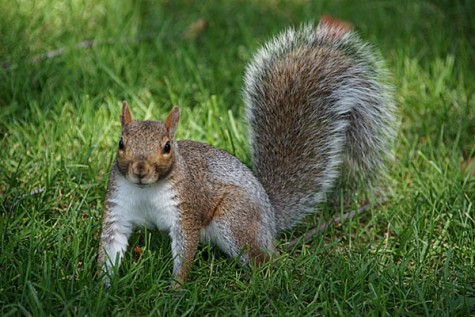Squeaky Squirrel Surplus
January 11, 2016
Every year we come back to school and find our furry little friends scurrying around outside in the trees, on power lines, or on the ground. There is one difference this year compared to all the rest; there is an extremely large amount of squirrels around St. Edward this year. “Usually seeing a nice, plump, little squirrel is the highlight of my day,” exclaimed senior Adam Radcliffe, “but this year the surplus of squirrels is NUTS!”
The squirrels you see in backyards and in neighborhoods, like where St. Eds is located, are grey squirrels. These little critters are actually indigenous to forests but overtime their friendly wooded homelands have been destroyed and replaced by farmland or new neighborhoods. The squirrels must adapt so they seek refuge in places where they feel there are no predators, such as the friendly confines of St. Edward.
The St. Edward squirrels will be harder to see around now a days due to the fact that the weather is getting colder. Contrary to popular belief, the grey squirrel does not hibernate. Their tiny squirrel bodies cannot hold enough body fat for them to self-sustain through all of winter. When seasons start to change and it starts to get cooler outside the squirrels find a dry, warm, place to reside during the bitter winter months. After they find a place to stay, they store nuts and seeds either in or around where they will be staying.
This does not mean you won’t see them around at all. You’ll see our little squirrel friends coming out of hiding to grab food or maybe to have snowball fights with their friends. If they are to ever run out of the food they have stored up during the winter they will go crazy and eat small birds and insects. So be careful if you see a grey squirrel out in the winter. Do not approach it or try to feed it. It may attack you.
Grey squirrels have certain warning signals they give off to alert that there is a predator nearby. The first vocal signal is a kuk which is a short, sharp, and broad frequency sound. “Imagine a dog barking and then speed it up and shorten it down to squirrel-size,” said Thaddeus McRae, a squirrel expert. The next vocal sign is the quaa which is very similar to the kuk but is much longer and dragged out. The squirrels also use their tail to alert of predators. They have two signals, the twitch and the flag. A twitch is a wave running through the tail. It’s a controlled motion where the tip makes a simple arc. A flag is a whipping motion of the tail, it is very uncontrolled. If you see a squirrel ever giving these signs, do not try to run. Squirrels are very fast and will catch you right away. Your best bet is to square up and try to fight it straight up.
Do not let this frighten you; most squirrels are very nice creatures. We all remember or brave squirrel friend, Sparky, who took one for the team and got us a day off of school earlier this year when he chewed his little squirrel way through a powerline. Squirrels teeth grow very fast and they have to continuously sharpen and shorten them. Urban squirrels have discovered that the thick rubber wiring around electrical lines work great to do that.
We here at the Edge staff hope there are no more squirrel fatalities this year. Squirrels are a blessing from God put on this earth for all of us to enjoy which is exactly what we should do. Show your friends some love by giving them a kuk or a quaa when you see them in the halls today and be sure to give every friendly squirrel and nice little wave when you see them.

Grey Squirrel


